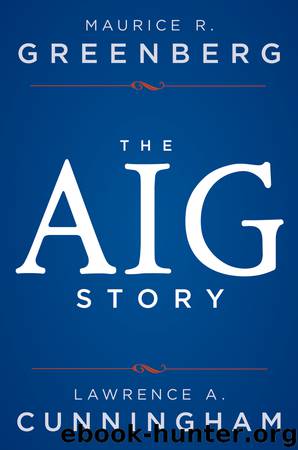The AIG Story by Maurice R. Greenberg & Lawrence A. Cunningham

Author:Maurice R. Greenberg & Lawrence A. Cunningham
Language: eng
Format: epub
Publisher: Wiley
Published: 2012-12-21T16:00:00+00:00
Chapter 11
Investments
In 1993, Peter G. Peterson, the renowned financier and cofounder of the Blackstone Group, invited Greenberg to invest in the pioneering firm. AIG bought a direct 7 percent stake, for $150 million, among the few outside positions ever taken in the private company. The participation of AIG, with its reputation for skilled risk analysis and financial astuteness, helped Peterson attract other investors to Blackstone’s funds. Blackstone eventually owned companies boasting some 100,000 employees and 10 years later went public. Blackstone’s initial public offering raised $30 billion. AIG’s share was worth $2.1 billion, which yielded it a compound annual growth rate exceeding 30 percent. In addition to the pleasure of playing a key role developing Blackstone, one of its era’s great financial successes, it was a lucrative way to invest AIG’s growing capital.
AIG began to accumulate substantial corporate capital in the 1980s, which grew to enormous sums through the 1990s and early 2000s. Investment of AIG’s capital was always handled separately from the insurance operations that generated the underwriting profits that drove this capital accumulation. Unlike other insurance companies, success for the insurance executives was defined solely in terms of insurance operations, rather than in terms of the yield on investments. Owing to the growth capital from insurance underwriting, the investment operation became increasingly important.
Reflecting the quality of AIG’s businesses, the credit rating agencies assigned it the best possible rating: AAA. Such a rating was a badge of capital strength only few American companies enjoyed. The AAA rating enhances a corporation’s position in any financial transaction, from borrowing on more favorable terms to guaranteeing commitments without needing to post collateral. Greenberg defended the AAA rating vigorously. It was common knowledge around AIG that anyone who jeopardized the rating would walk the corporate plank. AIG sought to use its AAA rating in existing businesses and to scout for other opportunities where it would yield economic gains.
One chapter in the search for rewarding investments occurred in the spring of 1990. James D. Wolfensohn, the prominent banker who later became president of the World Bank, called Greenberg about a potential acquisition for AIG. The target was International Lease Finance Corporation (ILFC), a pioneer in commercial aircraft leasing. It then owned 100 planes that it leased to airlines around the world. To grow, it needed capital. Wolfensohn wanted to know if AIG would supply it. Greenberg did not know much about the aircraft leasing business, but AIG was a large insurer of airlines and he knew a lot about aviation.
Leslie Gonda, ILFC’s chairman, hosted a meeting in Los Angeles with Greenberg and Ed Matthews, then AIG’s vice chairman of finance, along with Gonda’s son, Louis, and Louis’s friend, Steven Hazy. Gonda explained that, in 1946, he had emigrated from Hungary to escape the communist takeover, moving first to Venezuela and later to Southern California. Hazy’s parents, also Hungarian, had left their native land to flee the 1956 uprising in Budapest.
Aside from their Hungarian heritage, the three shared an entrepreneurial streak and a passion for aviation.
Download
This site does not store any files on its server. We only index and link to content provided by other sites. Please contact the content providers to delete copyright contents if any and email us, we'll remove relevant links or contents immediately.
| Automobile | Business |
| Casualty | Health |
| Liability | Life |
| Property | Risk Management |
The Secrets of Successful Financial Planning by Dan Gallagher(1495)
A Knight's Reward by Catherine Kean(1317)
An American Sickness by Elisabeth Rosenthal(1236)
Against the Gods by Peter L. Bernstein(1089)
FREAKONOMICS by levitt steven d(1078)
America's Bitter Pill: Money, Politics, Backroom Deals, and the Fight to Fix Our Broken Healthcare System by Steven Brill(1063)
SuperFreakonomics by Steven D. Levitt(1063)
America's Bitter Pill by Steven Brill(1035)
Risk Management Framework by James Broad(1018)
The Globetrotter's Guide to Travel Insurance: Travel Smarter, Pay Less, Get the Right Coverge (The Savvy Traveler Series Book 1) by Bauche Michael & Bauche Yvonne(1011)
A Practical Introduction to Security and Risk Management by Bruce Oliver Newsome(1009)
Strategic Risk Taking: A Framework for Risk Management by Aswath Damodaran(1004)
2019 Social Security & Medicare Facts by Michael D. Thomas(1001)
The New Frontier Investors by Jagdeep Singh Bachher Adam D. Dixon & Ashby H. B. Monk(995)
Game Changers by Rudolf Taschner(992)
How Our Days Became Numbered: Risk and the Rise of the Statistical Individual by Dan Bouk(983)
The 8 Characteristics of the Awesome Adjuster by Carl van Lamsweerde(917)
SUPERFREAKONOMICS by levitt steven d(913)
The Advisor Playbook: Regain Liberation and Order in your Personal and Professional Life by Duncan MacPherson & Chris Jeppesen(878)
